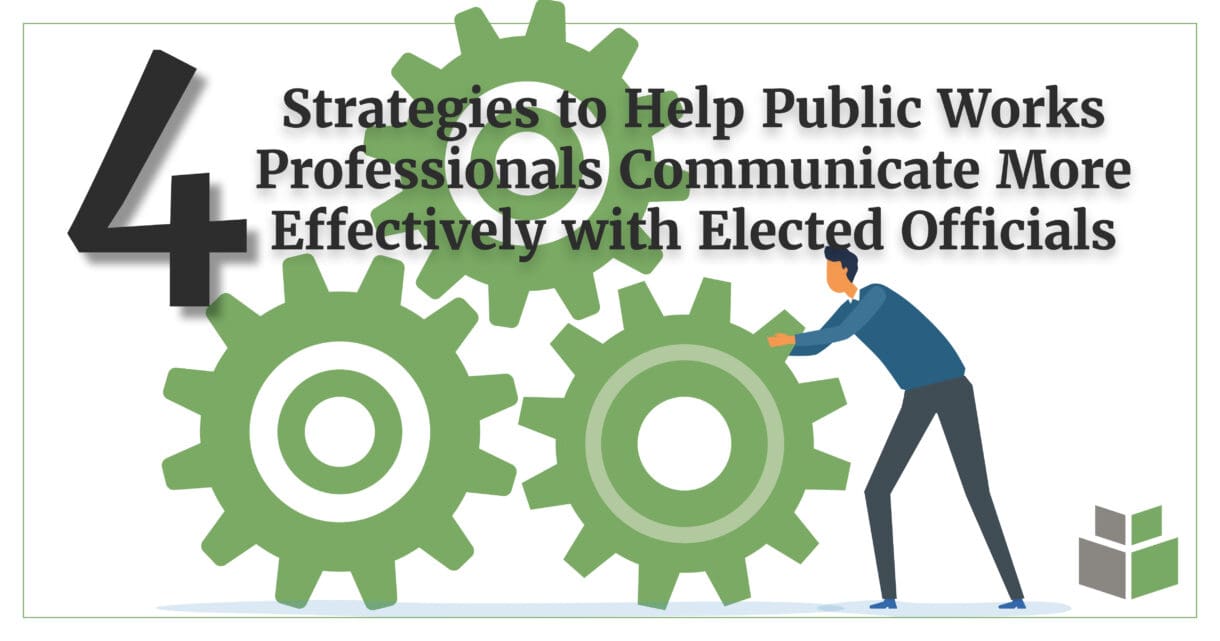
Public works professionals and elected officials often share a common mission: building stronger, more resilient communities. However, even when both parties are working toward the same goals, a communication gap can emerge, especially when technical language becomes a barrier.
You may be well-versed in asset management, pavement condition ratings, or water infrastructure, but that expertise can be difficult to translate to someone without a technical background. Misunderstandings can delay decisions, misalign priorities, or stall progress on critical projects. The key is learning to communicate technical information in a way that builds trust, drives clarity, and supports shared goals.
Here are four practical strategies to help public works professionals close the gap and get your message across effectively.
Know Your Audience
Understanding who you’re talking to is critical. Each elected official brings their own experiences, values, and communication preferences to the table. Some may be more data-driven, while others focus on public perception or long-term impact. Some may be facing re-election and feeling political pressure, while others may be newly elected and still learning the ropes. If you want a “yes” vote, you need to understand what matters most to them and speak to it.
Reframe the conversations away from a project list to levels of service. Show them the why behind requests. Focus on the outcomes the community will feel: smoother streets, fewer complaints, avoided failures, reduced costs down the road.
Tip: Do your homework on each council member. Tailor your message to align with what matters most to them.
“Knowing your audience is paramount,” says Town of Cary Mayor Harold Weinbrecht. “You really need to understand the council members individually. Your approach should shift depending on their experience and the political context.”
Show the Story: Simplify Through Visuals
Forget jargon. A council member doesn’t need to understand what Pavement Condition Index (PCI) 60 means, but they’ll absolutely react to a picture of a road with potholes and cracking. A simple graphic showing the cost of “do nothing” vs. showing variations of “act now” can be more influential than a 10-page report.
Tip: Show scenarios and outcomes side by side. Highlight “what happens if we act” versus “what happens if we don’t.”
“Visual aids are perfect,” Mayor Weinbrecht adds. “They help show the consequences of a decision. It’s important to present the full range of scenarios so everyone understands the impact of action—or inaction.”
Timing Is Everything
Elected officials often change their posture, subtly or significantly, once they seek reelection. This may be a full year ahead of the election, not just when they officially file. During this period, difficult decisions become harder to support. Understanding this political rhythm can be the difference between momentum and a hard stop.
Tip: Map your asks to term cycles. If a project is likely to be politically sensitive, especially if it involves raising rates or taxes, consider delaying or advancing the request to align with quieter political periods.
“Election cycles change everything,” Mayor Weinbrecht notes. “If a vote might be used against them later, even a strong case may not be enough.”
Rehearse for the Public Stage
Live meetings are performances. It’s not the time to reveal new information or improvise. If elected officials are going to support your plan in public, they need time to digest it, ask questions, and feel confident answering their constituents. That happens in advanced work sessions, briefings, and practice runs.
Tip: Hold pre-meeting work sessions to review options and rehearse questions. It’s not just about what’s said, it’s about how prepared everyone looks when they say it.
Building Bridges, Not Barriers
Effective communication between public works professionals and elected officials is essential to turning plans into progress. When you take the time to tailor your message, use visual tools, simplify complex ideas, and speak with authority, you foster alignment, trust, and momentum.
At the end of the day, your technical knowledge is what drives infrastructure forward, but your ability to communicate it is what earns support, secures funding, and gets projects across the finish line. Speak their language, and they’ll help you build a better community.
Additional Resources:
Are you listening? Effective communication with elected officials
